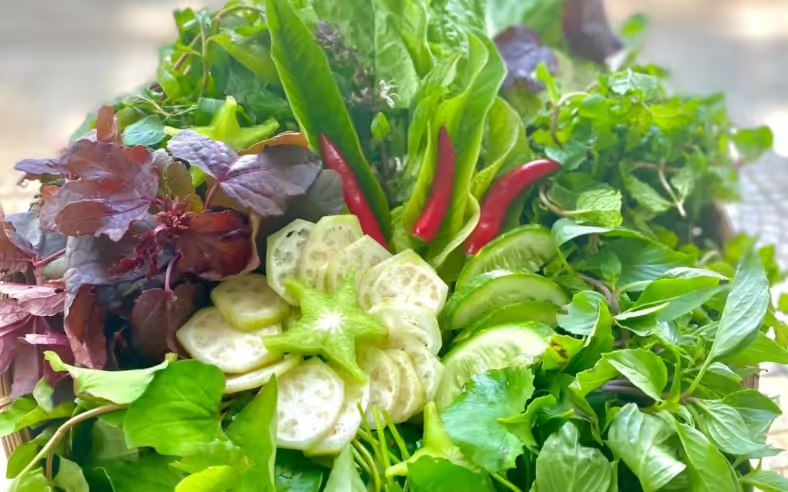
Vietnamese Herbs: 15+ Essential Varieties You Need to Know+ Vietnamese Names, Flavours, and a Free PDF Guide
Get ready to dive into the vibrant world of Vietnamese herbs! In this post, we’ll cover their local names, unique flavors, and how they’re used in everyday cooking. We’ve included a FAQ section to answer common questions. As a bonus, stick around until the end for a free PDF guide!
Inforgraphic
15+ Vietnamese herbs
Conclusion
Vietnamemese herbs FAQs
Bonus section

Discover common Vietnamese herbs
1. Green onion
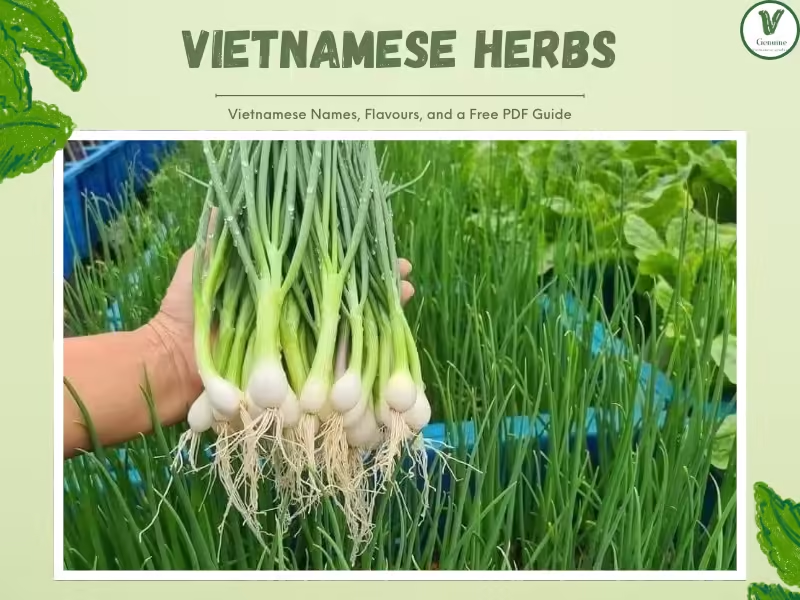
Overview
Vietnamese name: Hanh la
Flavor: Mild onion flavor with a hint of garlic. The white bulb tastes slightly different from the green tops.
Common dishes: Pho (Vietnamese noodle soup), bun bo (beef noodle soup), mi Quang (Quang noodles), and as a garnish for many Vietnamese dishes.
Green onions, one of the most popular Vietnamese herbs, are a versatile ingredient widely used in various dishes for their fresh flavor and aroma.
Green leaves: The green tops are the most commonly used part, often chopped and sprinkled over soups, pho, and noodle dishes, right before serving. They add a fresh pop of color and a mild onion aroma.
White bulb: In Vietnamese cooking, the white bulb of green onions is often the first ingredient added to hot oil or fat. This step, called ‘phi hanh,’ brings out the onion’s natural sweetness and creates a flavorful, fragrant base before adding other ingredients like meat or fish. This method adds a rich, savory aroma to the dish, enhancing its overall flavor.
2. Vietnamese coriander
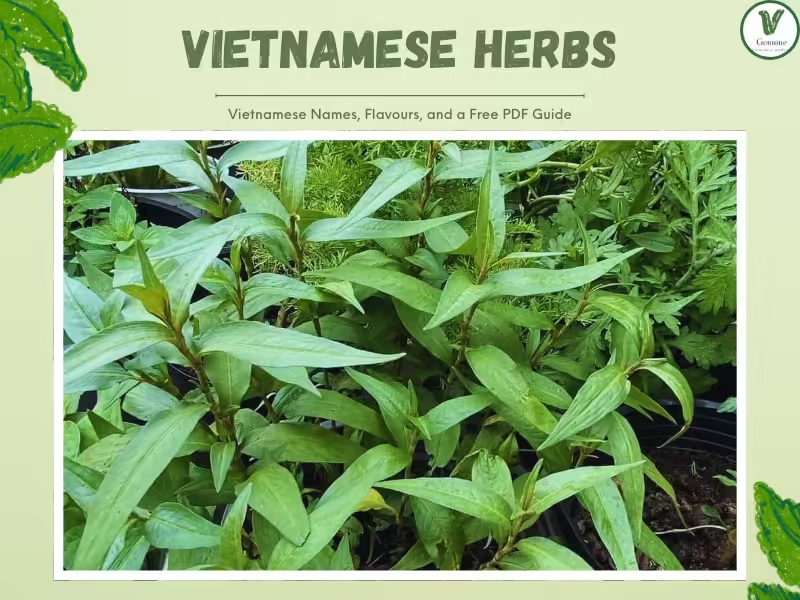
Vietnamese coriander pairs perfectly with both fertilized duck eggs (left) and Vietnamese chicken salad (right)
Overview
Vietnamese name: Rau ram
Flavor: Aromatic, herbal flavor with citrus, spice, and a peppery aftertaste.
Common dishes: goi ga (Vietnamese chicken salad), trung vit lon (fertilized duck egg),
In Vietnamese cuisine, Vietnamese coriander, known as ‘rau ram,’ is a popular herb that adds a distinctive, slightly peppery taste to many dishes. Vietnamese coriander has dark green leaves with brown spots on top and a reddish-purple hue underneath. In ideal conditions, it can grow 6 to 12 inches (15–30 cm) tall and spread up to 24 inches (60 cm). It’s commonly used in dishes like goi ga (Vietnamese chicken salad), served alongside trung vit lon (fertilized duck egg), and added to canh ca diec (crucian carp soup)
3. Coriander
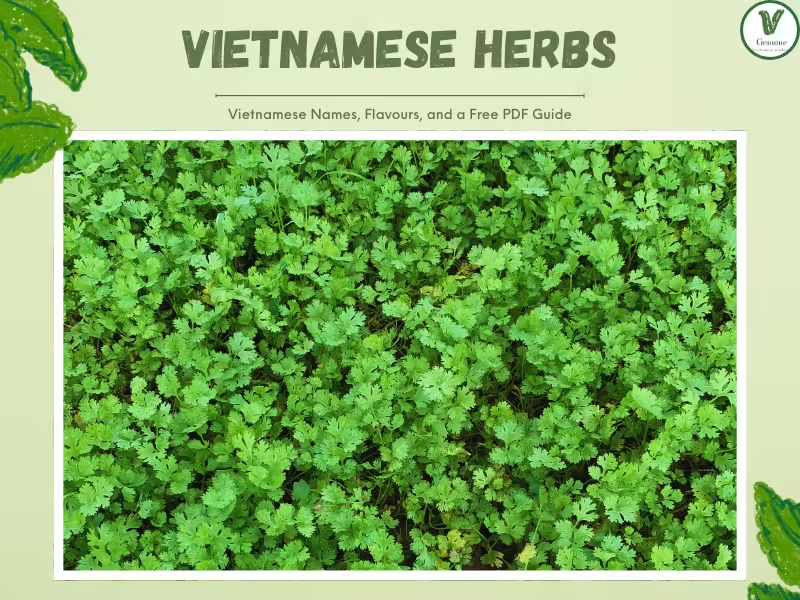
Coriander is commonly used as a garnish to make dishes look even more appetizing.
Overview
Vietnamese name: Ngo ri/ ngo/ rau mui
Flavor: Fresh, citrusy taste with a mild peppery kick.
Common dishes: Used in salads and as a garnish for various Vietnamese dishes
Coriander, or ngo ri, is a herb commonly used in everyday Vietnamese cooking, from stir-fries to soups and rice porridge. While many love its fresh taste, some people find the scent a bit strong. After cooking, it’s finely chopped and sprinkled over dishes to add a burst of flavor and color. In addition to cooked dishes, Vietnamese people also enjoy using coriander in rau song, a refreshing blend of herbs and leafy greens.
In Vietnam, people often combine various herbs and leafy greens into what’s called rau song. These fresh herbs are commonly served as accompaniments to meals, adding aromatic and flavorful contrast to rich dishes like meats, fried foods, or grilled items. Rau song is typically enjoyed raw or lightly blanched, and it’s often wrapped or rolled with savory foods, added to hot pots, or chopped into noodle soups, bringing a burst of freshness that balances the richness of the main dishes.
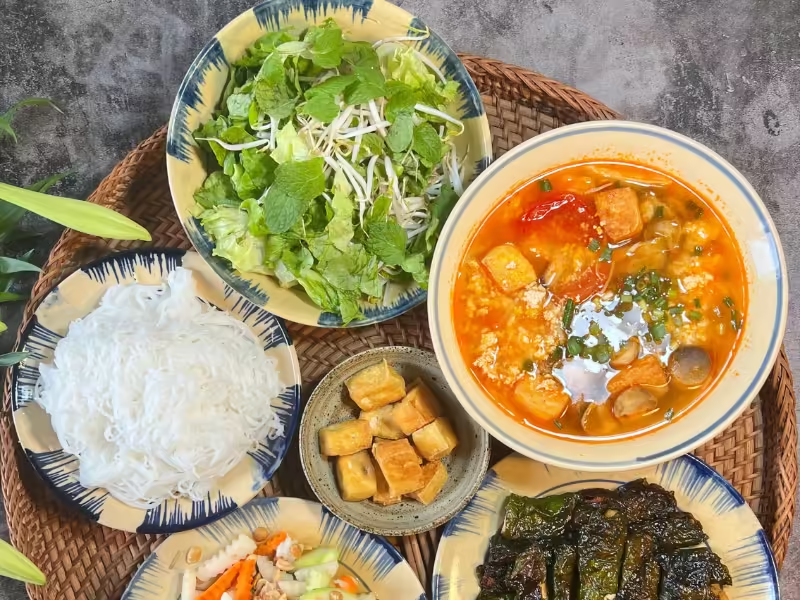
A plate of fresh Vietnamese greens (rau song), featuring a mix of herbs and vegetables
4. Thai basil
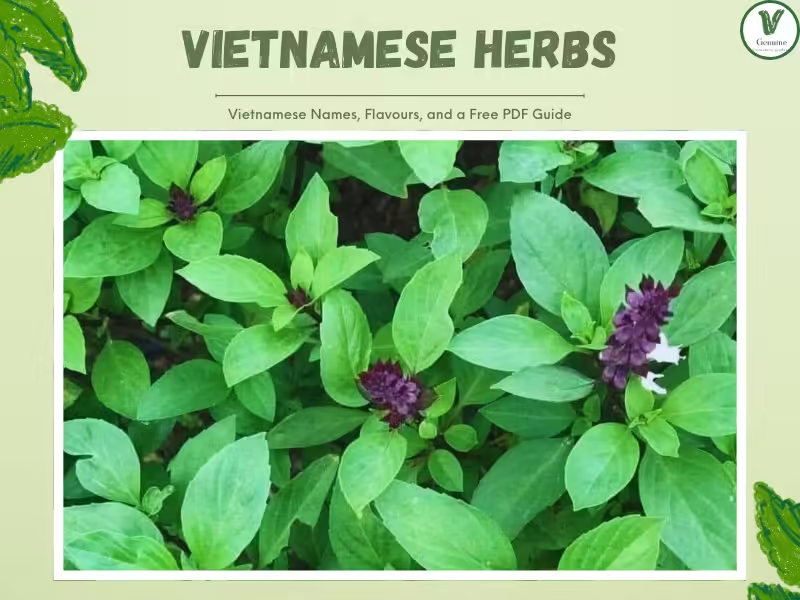
Thai basil is used in dishes like Bun Bo Hue and Pho.
Overview
Vietnamese name: Hung que
Flavor: Bold, spicy flavor with a hint of sweetness, similar to anise or licorice.
Common dishes: Pho (Vietnamese noodle soup), bun bo Hue (Hue beef noodle soup)
Thai basil, known as hung que in Vietnam, is a small, sturdy herb with distinctive purple stems and green leaves. When it blooms, the flowers are a delicate pink. The leaves have a sweet, anise-like fragrance with hints of licorice and a subtle spiciness. In Vietnamese cuisine, Thai basil is commonly served alongside beloved dishes like pho and bun bo Hue.
5. Lemon basil
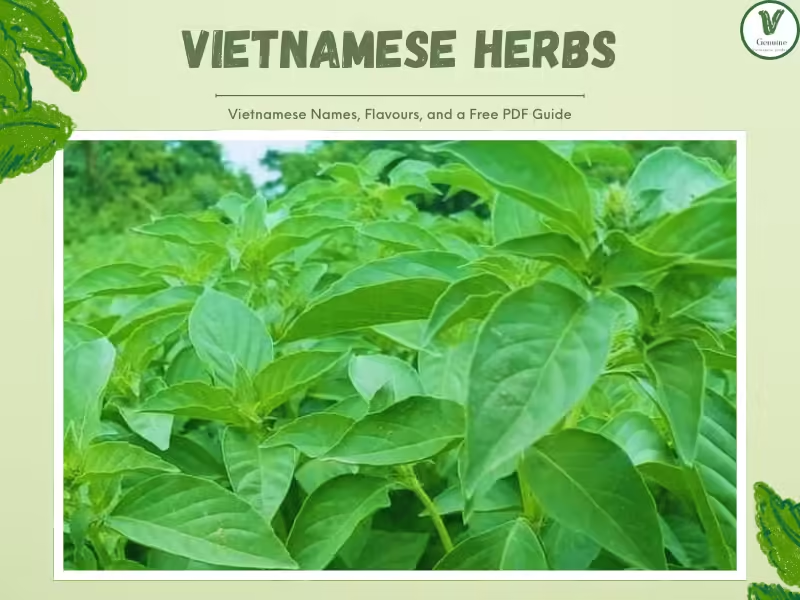
Chicken hotpot with lemon basil leaves (left) and a refreshing lemon basil seed drink (right).
Overview
Vietnamese name: E trang/ hung trang
Flavor: Herbal, sweet, tangy, with a hint of lemon and a touch of anise.
Common dishes: lau ga la e (chicken hotpot with lemon basil leaves), lemon basil seed drink.
Many people often confuse lemon basil (e trang) with Thai basil (hung que), but there are some key differences between the two. Thai basil has purple stems and white flowers, while lemon basil features green stems and white flowers. Another difference is that lemon basil leaves have tiny hairs and are generally smaller, whereas Thai basil leaves are smooth and larger.
In Vietnamese cuisine, lemon basil is a popular ingredient in dishes like lau ga la e (chicken hotpot with lemon basil leaves) and pairs well with other herbs in dishes like mi Quang (Quang noodles). The seeds of lemon basil are also used in a refreshing drink. To make it, Vietnamese people simmer the seeds with sugar and a few slices of ginger in water, then let it cool before serving it over ice for a simple and cooling beverage.
6. Lemon grass
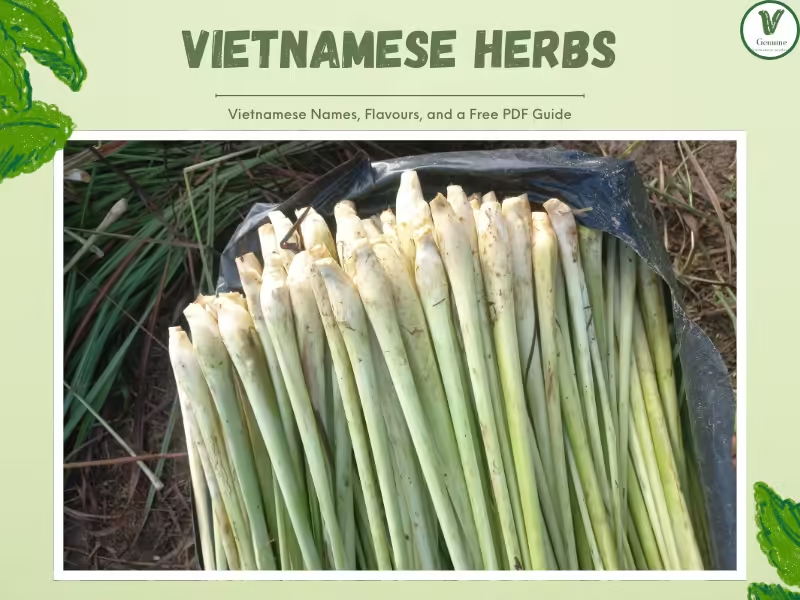
Lemongrass is used in noodle broth (left) or to marinate meat before stir-frying (right)
Overview
Vietnamese name: Sa
Flavor: A blend of citrusy lemon, floral notes, and a hint of ginger.
Common dishes: Beef noodle soup broth, Stir-fried frog with lemongrass and chili
Lemongrass is one of the essential herbs used in Vietnamese cooking, known for adding a delicious aroma to dishes. For example, in the famous Vietnamese dish bun bo (beef noodle soup), lemongrass is often added to the broth to give it a fragrant flavor. In Vietnam, lemongrass is also commonly chopped with fresh chili and used as a marinade for meats like chicken, beef, duck, or frog. This combination is then stir-fried, creating delicious dishes.
7. Culantro/ sawtooth coriander
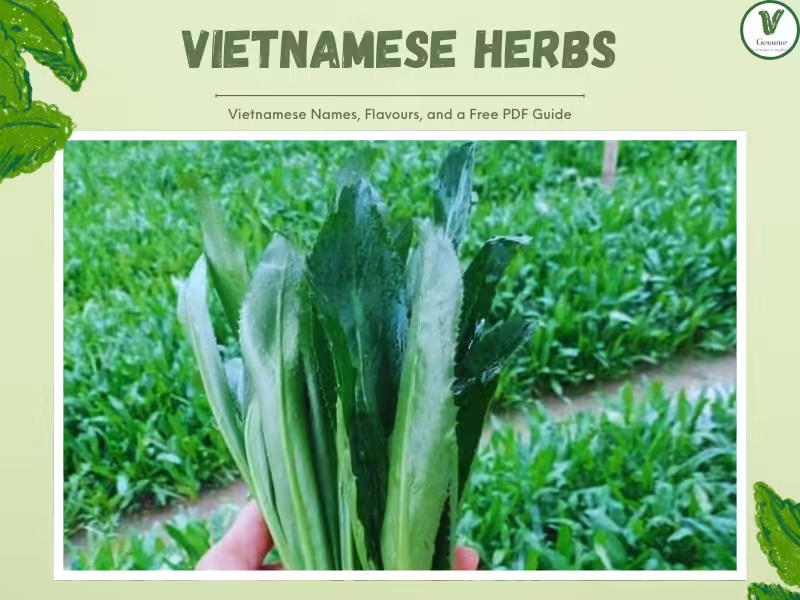
Culantro is used in sour fish soup (left) and as a garnish for dishes (right).
Overview
Vietnamese name: Ngo gai/ mui tau
Flavor: Strong, herbal flavor with a touch of citrusy bitterness.
Common dishes: Pho (Vietnamese noodle soup), canh chua ca (sour fish soup)
Culantro, or ngo gai, has a distinctive appearance with small serrated edges along both sides of its leaves. In Vietnamese cuisine, ngo gai is often used in dishes like pho, and canh chua ca (sour fish soup), adding a unique flavor. Vietnamese people also use ngo gai in juice, believing it offers various health benefits.
8. Perilla leaf
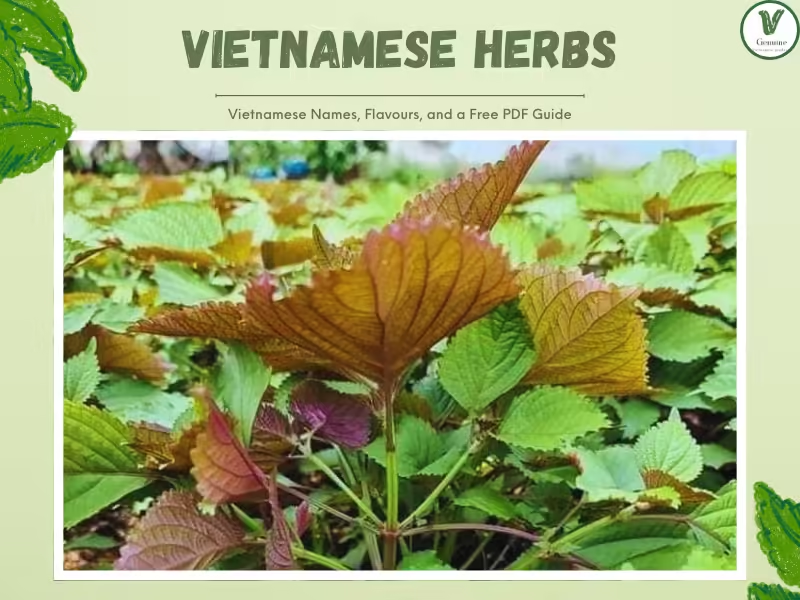
Perilla leaves are used in grilled pork with rice vermicelli (left) and eel porridge (right)
Overview
Vietnamese name: tia to
Flavor: Bold and aromatic with hints of mint, basil, anise, and a touch of acidity
Common dishes: bun cha (grilled pork with rice vermicelli), chao luon (eel porridge)
In Vietnam, perilla (tia to) is a herb that grows to about 50-60 cm tall. Its leaves are green on top and purple underneath, though some varieties are fully green or fully purple. The plant has a fragrant aroma and a slightly fuzzy texture. Perilla leaves are popular as a fresh herb in dishes like bun cha (grilled pork with rice vermicelli), and they’re often added to rice porridge, especially eel porridge, where their unique flavor really shines. Vietnamese people also brew perilla leaves into tea, which is believed to support digestion and improve skin health.
9. Garlic chives
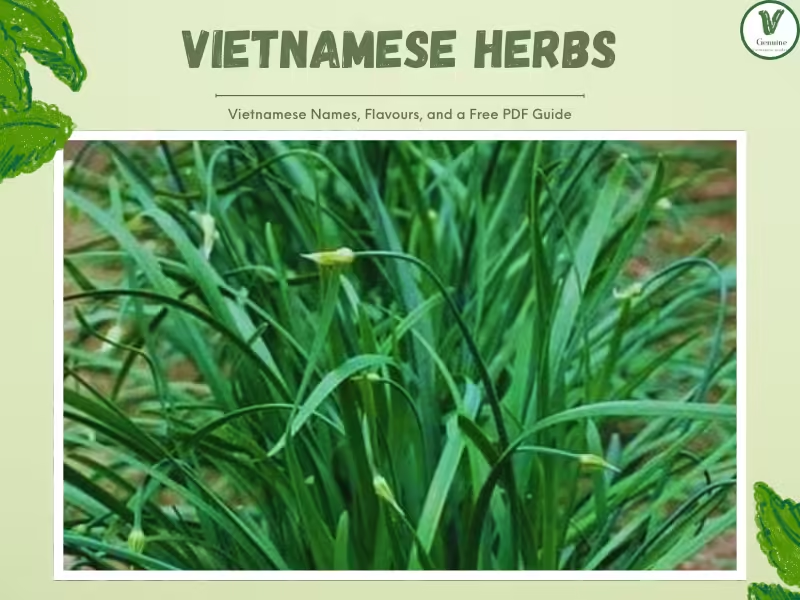
Garlic chives are used in chive noodle soup.
Overview
Vietnamese name: La he
Flavor: Mild, subtle flavor that combines hints of garlic and onion.
Common dishes: banh canh he (chive noodle soup)
In Vietnam, he (garlic chives) grows easily thanks to the ideal climate and is found in gardens across the country. The leaves are flat, vibrant green, and typically range from 20 to 40 cm in length. They have a mild, subtle flavor that combines hints of garlic and onion, which adds a unique touch to many dishes. Although garlic chives are available year-round, it’s considered best in spring when its flavor and quality are thought to peak. In Vietnamese cooking, it’s often featured in comforting dishes like banh canh he (chive noodle soup), a thick noodle soup made with fish cakes, pork bones, thick Vietnamese noodles, and fresh chives.
10. Fish mint
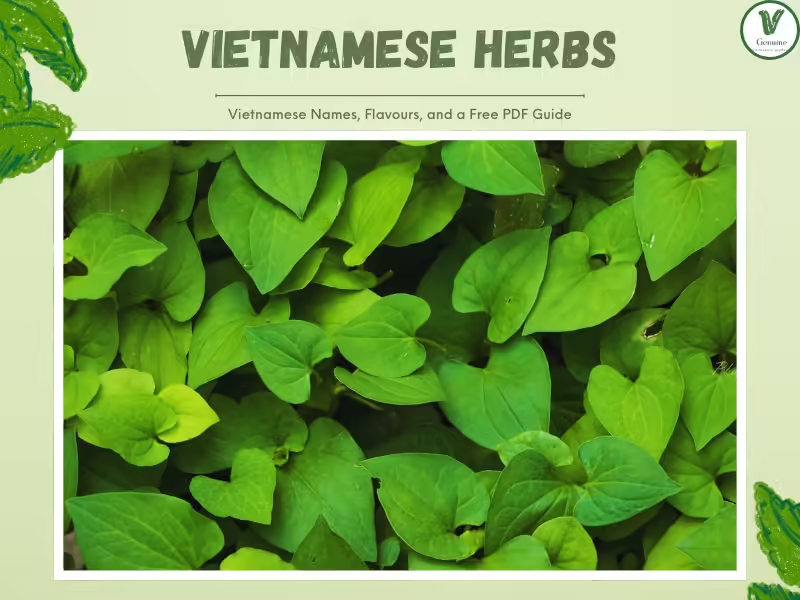
Fish mint is used in Vietnamese pancakes (left) or combined with other herbs to make rau song (right).
Overview
Vietnamese name: Diep ca
Flavor: Bold flavor, with a mild sourness, a metallic undertone, and a distinct fishy taste.
Common dishes: banh xeo (Vietnamese pancake)
In Vietnam, diep ca, or Vietnamese fish mint, grows year-round in gardens, especially in moist, shaded areas. The leaves are heart-shaped and green, while the flowers are small, with a pale white or yellowish color. The flavor of diep ca is unique—it’s tangy with a hint of spice. Some people describe its taste as slightly fishy, though opinions vary! In Vietnamese cuisine, diep ca is often enjoyed fresh and served with grilled meats, fresh spring rolls, and crispy banh xeo (Vietnamese pancake). It’s also popular as a fresh juice ingredient, which many believe has health benefits.
11. Spearmint
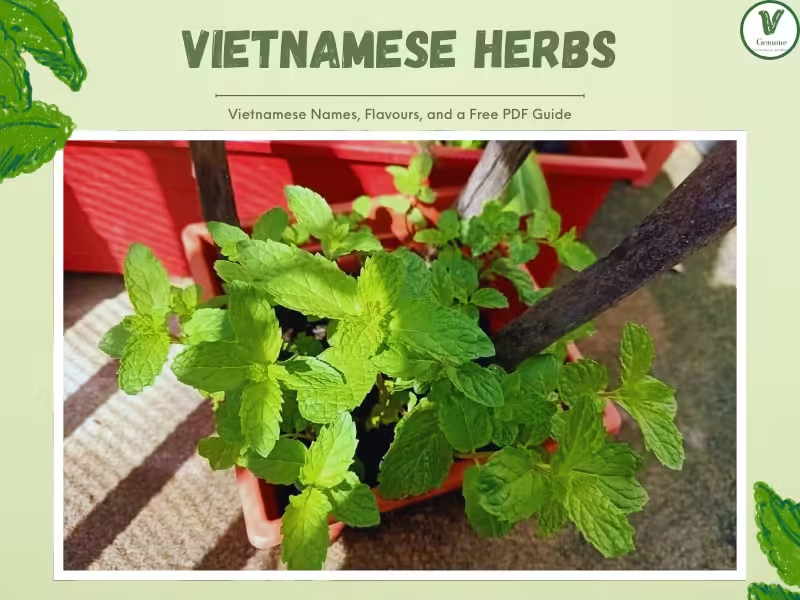
Spearmint is used in Mi Quang (left) and Vietnamese pancakes (right)
Overview
Vietnamese name: Hung lui
Flavor: Sweet, mildly tangy flavor with subtle hints of citrus and spice
Common dishes: Mi Quang (Quang noodles)
In Vietnam, spearmint, or hung lui, is a fragrant herb with shallow roots that spread close to the soil’s surface. The plant grows to about 50–60 cm in height, with deep green leaves that are small, about 2–5 cm long and 1–3 cm wide. The leaves have a soft layer of fuzz on both sides and finely serrated edges. Hung lui has a fresh, mild mint flavor and is often combined with other herbs, especially as a topping for dishes like mi Quang (Quang noodles).
12. Peppermint
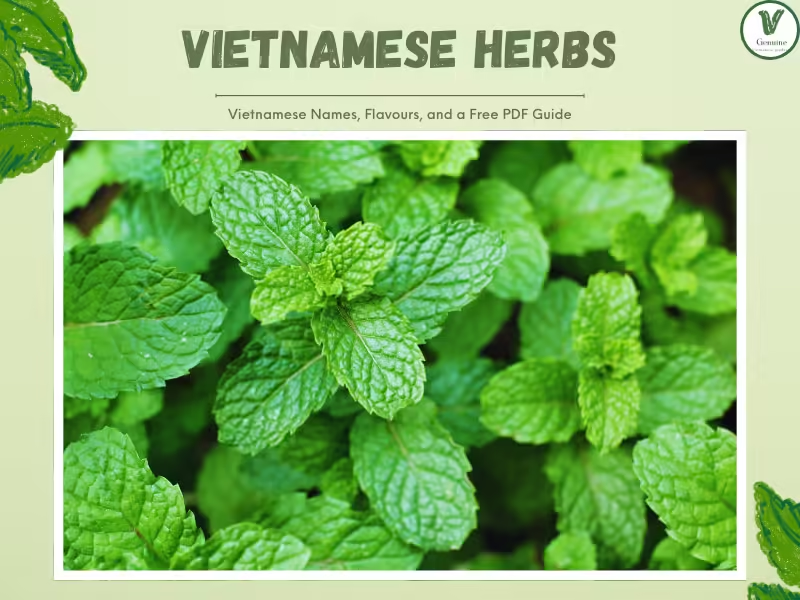
Overview
Vietnamese name: Bac ha
Flavor: strong, cooling flavor that’s refreshing with a hint of spiciness.
Common dishes: Commonly used in beverages
Many people still get confused between peppermint and spearmint because they look quite similar. In reality, though, spearmint has a milder, sweeter taste compared to peppermint, thanks to its lower menthol content. Peppermint contains forty percent menthol, which is what gives peppermint leaves their numbing, cooling effect.
13. Vietnamese balm
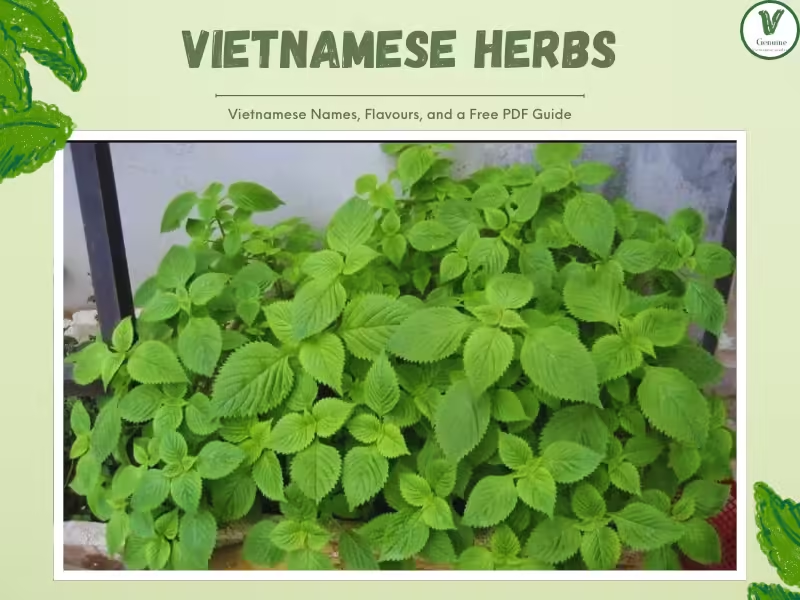
Vietnamese balm is used in dishes like bun dau mam tom (left) and bun cha (right)
Overview
Vietnamese name: Kinh gioi
Flavor: A flavor that combines lemon, mint, and a touch of spice.
Common dishes: bun dau mam tom ((rice vermicelli with fried tofu and shrimp paste), bun oc (snail vermicelli soup), bun rieu cua (Vietnamese crab noodle soup).
In Vietnam, Vietnamese balm (known as kinh gioi) is a fragrant herb that grows to about 30–50 cm tall and is very easy to cultivate. The leaves are small, around 2–5 cm long, with serrated edges. It has a mild, spicy flavor and a pleasant aroma due to the essential oils it contains. Although it looks similar to perilla (tia to), Vietnamese balm is a different herb. Its leaves are smaller and bright green on top, while perilla leaves are typically more purple, especially underneath.
In Vietnamese cuisine, Vietnamese Balm is often used fresh, adding a burst of flavor to dishes like boiled pork wrapped in rice paper, bun oc (snail vermicelli soup), bun rieu cua (Vietnamese crab noodle soup), bun dau mam tom ((rice vermicelli with fried tofu and shrimp paste), and bun cha (grilled pork with noodles).
14. Wild betel/ piper lolot
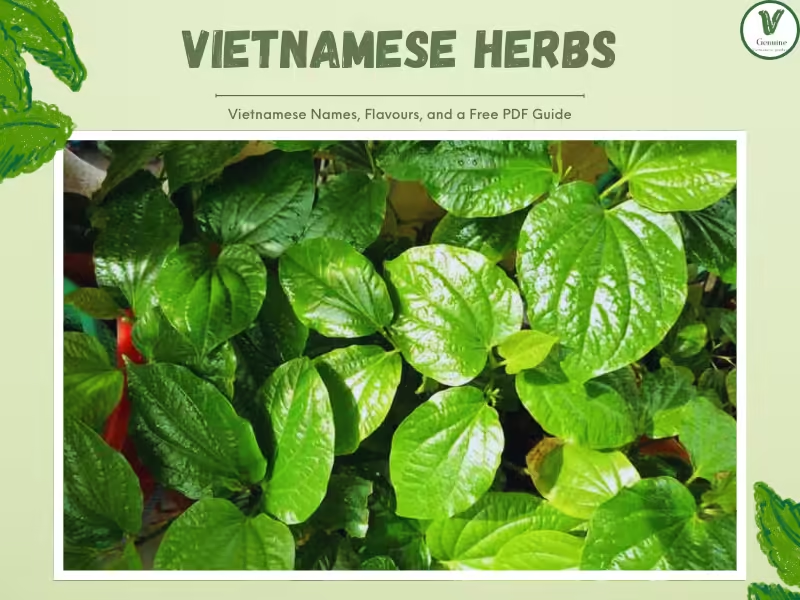
Piper lolot is used in dishes such as ‘Bo cuon la lot’ (left) and ‘Bo xao la lot’ (right).
Overview
Vietnamese name: La lot
Flavor: Strong aroma, slightly spicy taste, and a mild herbal, minty flavor when cooked.
Common dishes: Thit bo cuon la lot (grilled beef wrapped in piper lolot leaves)
Piper lolot leaves are thin, heart-shaped, and typically about 10–14 cm long and 5–8 cm wide. They are often confused with betel leaves, but these two are actually quite different. Piper lolot leaves have a much more pleasant, aromatic fragrance and are used in cooking, unlike betel leaves. In Vietnamese cuisine, piper lolot leaves are a key ingredient in dishes like thit bo cuon la lot (grilled beef wrapped in piper lolot leaves) and Thit bo xao la lot (stir-fried beef with piper lolot leaves).
15. Celery
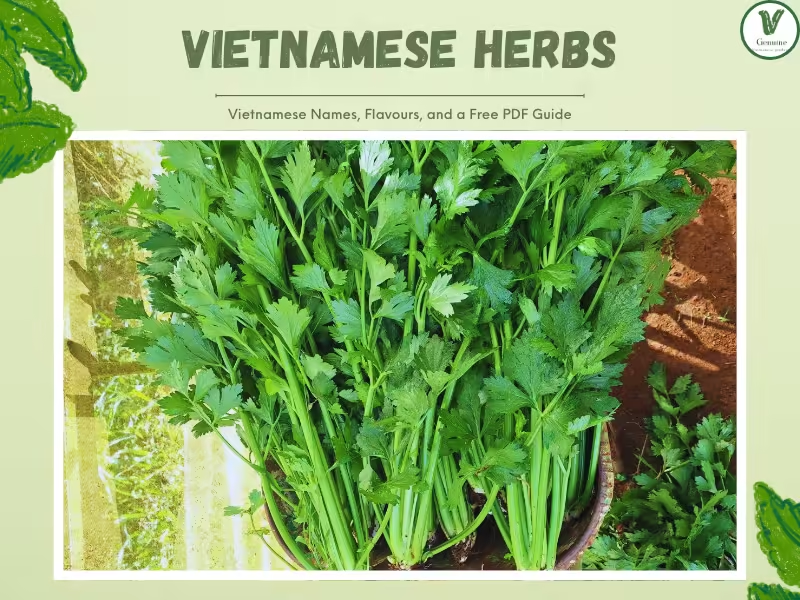
Overview
Vietnamese name: Can tay
Flavor: A mild bitterness, paired with a crisp texture that’s juicy and refreshing.
Common dishes: Hu tieu Nam Vang (Nam Vang noodle soup)
Celery is one of the versatile Vietnamese cooking herbs, enjoyed not only as a juice but also in stir-fries like squid with celery and beef with celery. It’s especially key in hu tieu Nam Vang (Nam Vang noodle soup), a delicious noodle dish made with transparent rice noodles and topped with pork liver, ground pork, quail eggs, fried shallots, garlic, and poached shrimp. Served with a mix of fresh garnishes—like garlic chives, celery, green onions, cilantro, and lettuce.
16. Dill
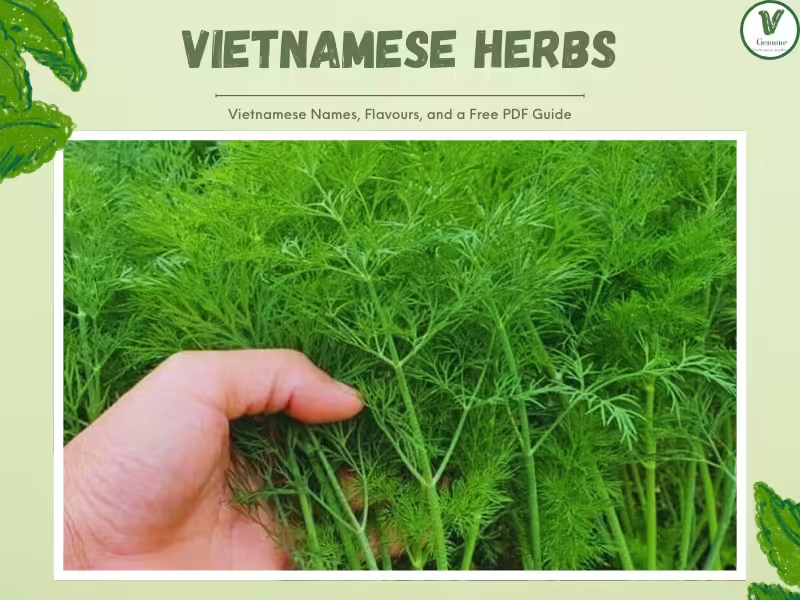
Dill is used in fish soups
Overview
Vietnamese name: Thi la
Flavor: Bright, refreshing flavor with citrusy notes and a subtle grassy undertone
Common dishes: Fish soups
In Vietnam, thi la, or dill, is loved for its fresh, distinct aroma. Its pleasant scent makes it a popular herb in Vietnamese cooking, especially in fish soups, where it’s used to balance and reduce any fishy odor.
Conclusion
Vietnamese herbs and vegetables are essential to creating the vibrant flavors of Vietnamese cuisine. From fresh garnishes to flavorful broths, these Vietnamese herbs for cooking can transform any dish into something truly special. Whether you’re growing them at home or picking them up at a local market, incorporating these herbs into your cooking is a simple way to add authenticity and freshness to your meals.
Here is a video about a famous vegetable village that grows various Vietnamese herbs and vegetables in Vietnam.
FAQs: What you need to know about Vietnamese herbs
Can you eat fresh herbs in Vietnam?
Yes, fresh herbs are widely enjoyed in Vietnam and are an important part of the cuisine. Herbs like Vietnamese coriander, fish mint, Thai basil, and perilla are commonly used in dishes like salads, spring rolls, and noodle bowls, adding a fresh, vibrant flavor. These herbs are usually served raw and are safe to eat. Just make sure to choose fresh, clean herbs from trusted sources.
How to propagate Vietnamese herbs?
Most Vietnamese herbs can be propagated through seeds or cuttings. For example, Vietnamese coriander can be grown from seeds by soaking them in warm water for about 4-6 hours to help them germinate faster. After that, the seeds are ready to be sown in the soil. Alternatively, you can propagate Vietnamese coriander using cuttings. Simply take healthy, strong stems about 12-15 cm long and plant them directly in the soil. This method works for many other Vietnamese herbs as well, making it easy to grow these flavorful plants at home!
What herbs are used in Vietnamese food?
Herbs are a key part of Vietnamese cuisine and add fresh flavors to many dishes. Some, like green onions and lemongrass, are used to marinate meats, giving them extra flavor. Others, like Vietnamese coriander, are perfect for salads like chicken salad. After cooking, fresh herbs like cilantro and Thai basil are added for freshness. Herbs like fish mint, Thai basil, and perilla are often served with dishes like bun, pho, banh xeo, and goi cuon. And then, there’s celery, which is essential for stir-frying with beef or squid to create savory dishes.
What gives Vietnamese food its flavor?
The key ingredients that give Vietnamese food its flavor are fish sauce, herbs, and spices.
- Fish sauce (nuoc mam) is the backbone of Vietnamese cooking, providing a salty, umami-rich taste used in everything from soups to dipping sauces.
- Herbs like fresh green onions, Thai basil, Vietnamese coriander, and coriander bring freshness and fragrance to dishes.
- Spices like chili, pepper, garlic, ginger, lemongrass, and turmeric add depth, heat, and complexity, balancing savory, spicy, and aromatic flavors.
What are the benefits of Vietnamese herbs?
Vietnamese herbs are known for their health benefits, including improving digestion, boosting immunity, and offering anti-inflammatory properties. They add fresh flavors to dishes while contributing to overall well-being.
What are the purple leaves on Vietnamese herbs?
The purple leaves on Vietnamese herbs are from perilla (tia to). Perilla is used in certain Vietnamese dishes, such as grilled pork with rice vermicelli, and eel porridge, or even used to make tea.
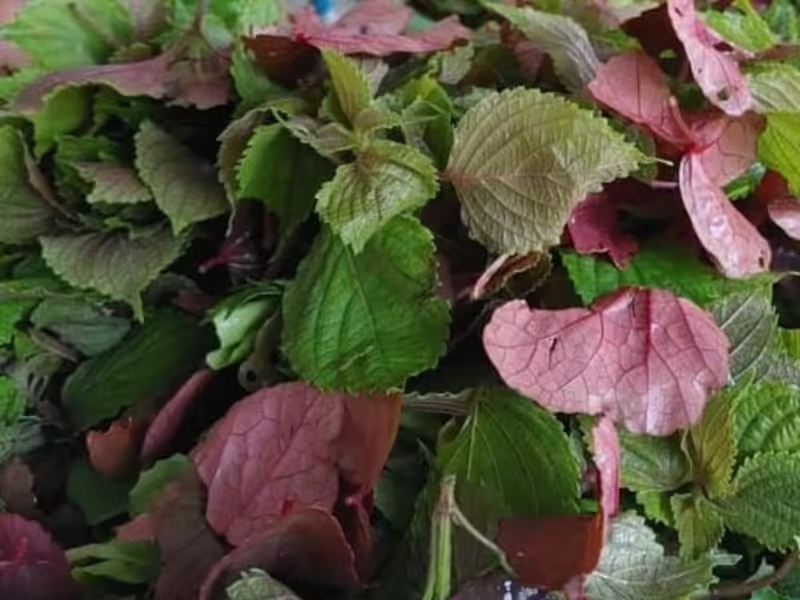
What are the herbs in pho?
Pho, the famous Vietnamese noodle soup, typically includes fresh herbs like green onions, Thai basil, cilantro, bean sprouts, and lime. These herbs are added to the dish to enhance its flavors, offering a fresh and aromatic balance to the rich, savory broth.
Why does Vietnamese food taste so good?
Vietnamese food tastes so good because of its balanced combination of fresh ingredients, herbs, spices, and sauces.
What are some Vietnamese herbs to grow from seed?
Some popular Vietnamese herbs that you can grow from seed include green onion (hanh la), Vietnamese coriander (rau ram), coriander (ngo), Thai basil (hung que), lemon basil (e trang), and culantro (ngo gai). For more details on how to grow and harvest them, download our free PDF guide!
What is the Vietnamese herb that smells like fish?
The Vietnamese herb that smells like fish is fish mint (la diep ca). Known for its unique, slightly fishy aroma, it’s commonly mixed with other herbs and served alongside dishes like Hue beef noodle soup, Vietnamese pancakes, or Quang noodles.
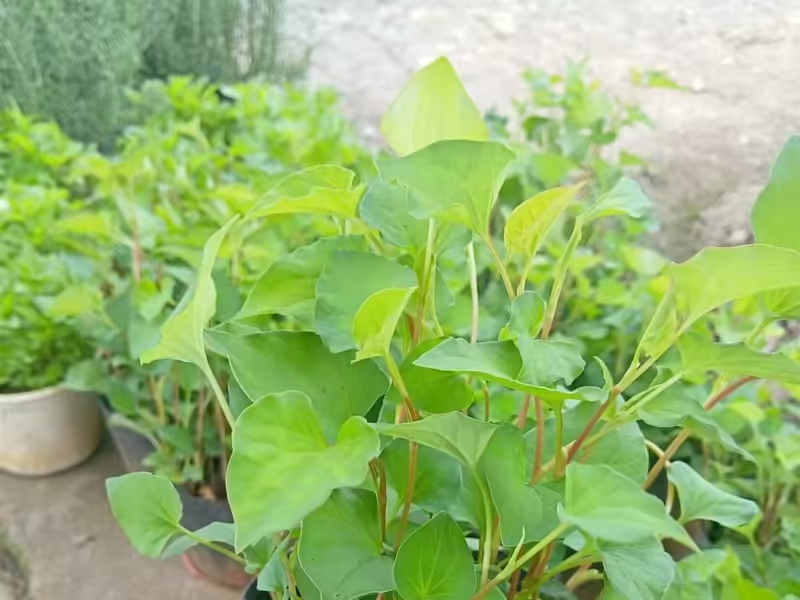
What is coriander called in Vietnam?
In Vietnam, coriander is called “ngo,” “ngo ri,” or “rau mui.” It’s a popular herb used in many Vietnamese dishes for its fresh, aromatic flavor.
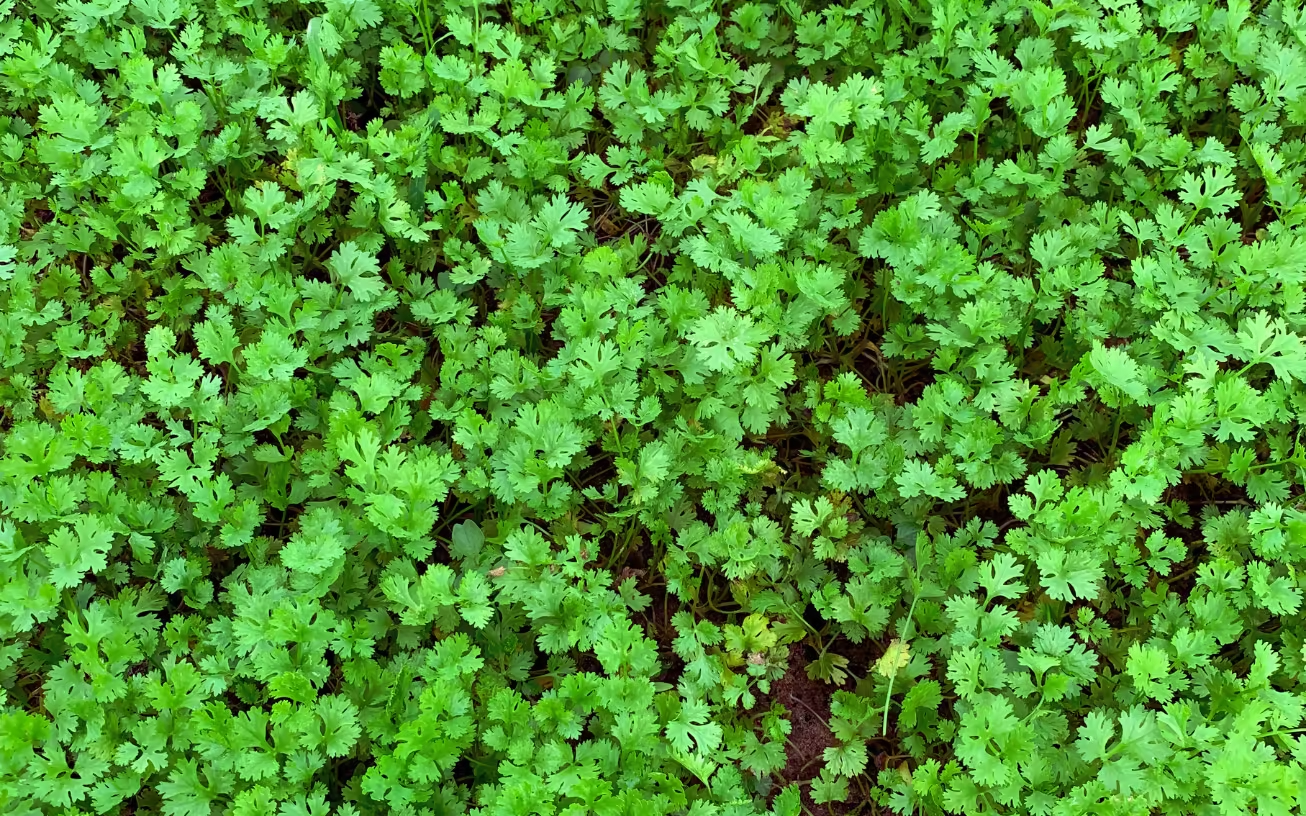
Do Vietnamese use rosemary?
No, rosemary is not commonly used in traditional Vietnamese cuisine. Instead, herbs like, green onion, Thai basil, cilantro, Vietnamese coriander, and lemongrass are more commonly used to add flavor to dishes.
Is Thai basil the same as Vietnamese mint?
No, Thai basil and Vietnamese mint are not the same. Thai basil has a sweet, anise-like scent with hints of licorice and a touch of spiciness. On the other hand, Vietnamese mint (also known as Vietnamese coriander) has a hot, biting, peppery aftertaste.
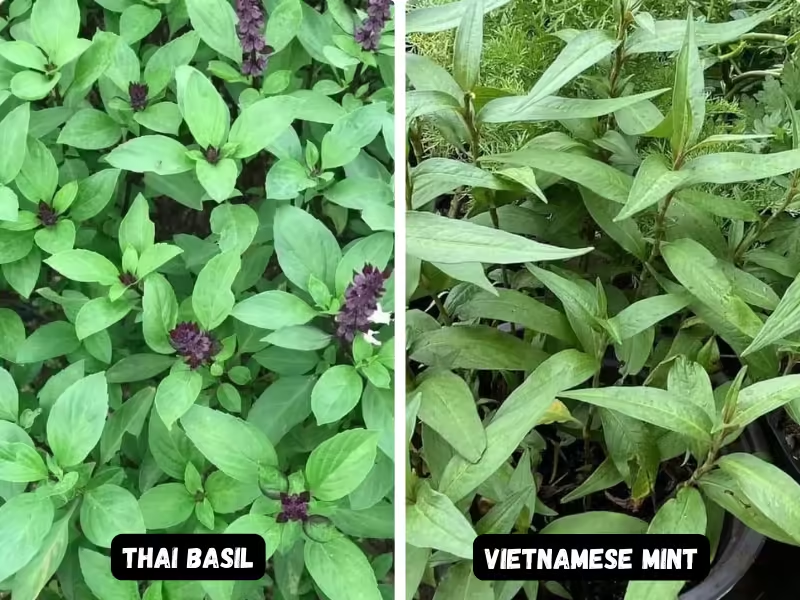
What type of basil is used in Vietnamese food?
In Vietnamese cuisine, the most common types of basil used are Thai basil and lemon basil. Both are often mixed with other herbs and served alongside dishes like Hue beef noodle soup, Pho, Vietnamese pancakes, or Quang noodles. The seeds of lemon basil are also used to make refreshing drinks.
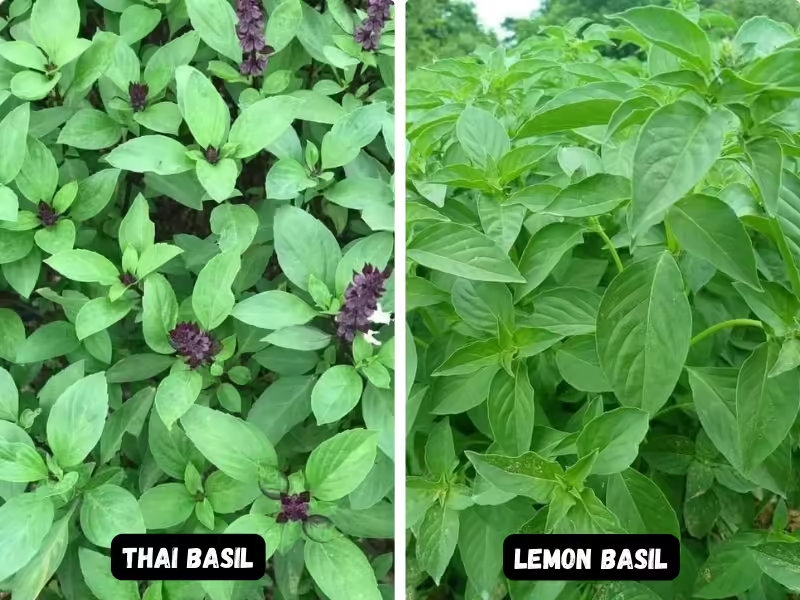
Bonus: Free PDF Guide to Vietnamese Herbs
What’s Inside This PDF Guide
VivaVN Team created this PDF to give you an overview of 16 common Vietnamese herbs. This Vietnamese herbs list includes detailed information about each herb, including:
Vietnamese names
Flavor profile
Growing method
Growing time
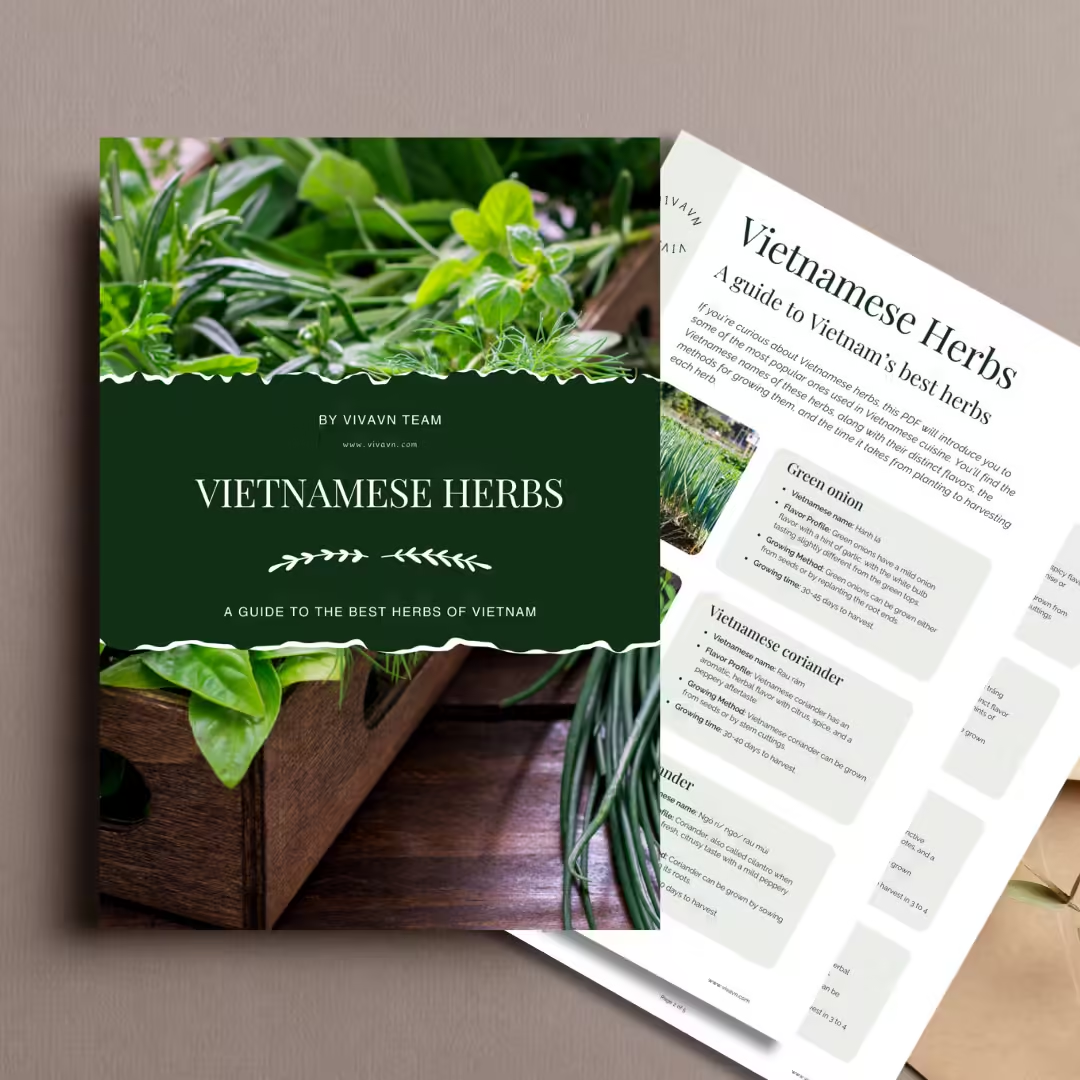
Share on FacebookShare on X (Twitter)Share on PinterestShare on WhatsappShare on LinkedinShare on TelegramShare on Email
- https://www.youtube.com/@VivaVNOfficial
- https://www.facebook.com/vivavnofficial2024
- https://www.pinterest.com/vivavnofficial/
© 2025 VivaVN. All rights reserved.


Leave a Reply